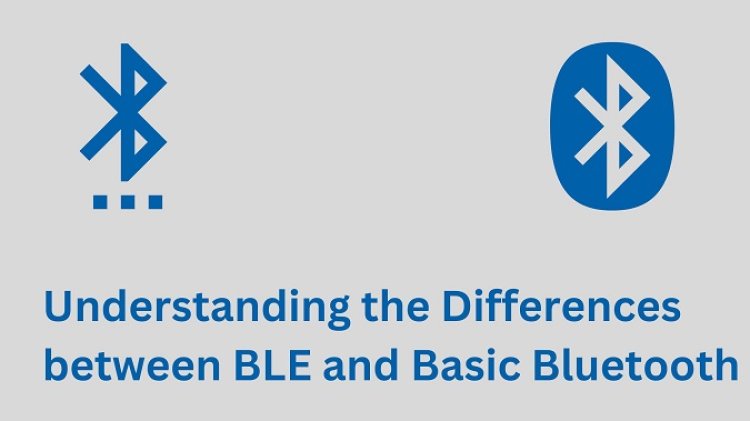Understanding the Differences between BLE and Basic Bluetooth
Discover the differences between Basic Bluetooth and BLE in wireless modules. Learn their features, use cases, and benefits to choose the right technology.
Share this Post to earn Money ( Upto ₹100 per 1000 Views )

Bluetooth technology has dramatically transformed the way we connect devices wirelessly, enabling smooth communication between devices and applications. Currently, there are two primary types of Bluetooth: Basic Bluetooth (also known as Classic Bluetooth) and Bluetooth Low Energy (BLE).
These technologies are often integrated into various wireless modules to enhance functionality. In this blog post, we’ll explore the differences between BLE and Basic Bluetooth, emphasizing their distinct features, use cases, and benefits.
What is Basic Bluetooth?
Basic Bluetooth, commonly known as Classic Bluetooth, was introduced in 1999. It is designed for continuous data transmission, such as audio streaming. Key features of Basic Bluetooth include:
- Data Rate: Offers a higher data rate than BLE, with speeds up to 3 Mbps (megabits per second).
- Power Consumption: Requires more power, which may not be ideal for battery-powered devices needing long-lasting battery life.
- Range: Typically extends up to 100 meters, though this can vary with environmental factors and device specifications.
- Applications: Widely used in devices requiring constant data transfer, including wireless headphones, speakers, and car infotainment systems.
What is Bluetooth Low Energy (BLE)?
Bluetooth Low Energy (BLE), introduced with Bluetooth 4.0 in 2010, is designed for applications requiring periodic data transfer. Key features of BLE include:
- Data Rate: Provides lower data rates compared to Basic Bluetooth, with speeds up to 1 Mbps.
- Power Consumption: Designed to be energy-efficient, making it perfect for battery-operated and rechargeable devices needing prolonged operational time.
- Range: Also has a range of up to 100 meters, similar to Basic Bluetooth, though it can vary depending on device and environmental conditions.
- Applications: Used in devices requiring intermittent data transfer and low power consumption, such as fitness trackers, smart watches, and health monitoring devices.
Key Differences Between BLE and Basic Bluetooth
|
Feature |
Basic Bluetooth |
Bluetooth Low Energy (BLE) |
|
Power Efficiency |
Consumes more power; suitable for devices that can be frequently charged. |
Highly energy-efficient; ideal for long-lasting battery-powered devices. |
|
Data Transfer |
Supports higher data transfer rates; ideal for applications like audio streaming. |
Supports lower data rates; suited for periodic data transfer applications. |
|
Latency |
Typically lower latency; beneficial for real-time applications like audio and video streaming. |
Slightly higher latency; acceptable for applications like fitness tracking and health monitoring. |
|
Complexity and Cost |
Generally more complex and often more expensive to implement. |
Simpler and often more cost-effective; suitable for a wide range of devices, including low-cost and small form-factor gadgets. |
Choosing Between BLE and Basic Bluetooth
The choice between BLE and Basic Bluetooth depends on the specific needs of your application:
- Power Requirements: For devices needing extended battery life, BLE is the preferred choice due to its low power consumption.
- Data Transfer Needs: Basic Bluetooth is better suited for applications requiring continuous, high-speed data transfer, such as audio or video streaming.
- Cost and Complexity: BLE is generally more affordable and simpler to implement, making it ideal for smaller, low-cost devices.
Conclusion
Both BLE and Basic Bluetooth have their advantages and are suited to different types of applications. Basic Bluetooth excels in high data rate applications with continuous data transfer needs, while BLE is ideal for low-power, intermittent data transfer. Understanding the differences between these technologies will help you make an informed choice when designing or selecting Bluetooth-enabled devices.
By choosing the right Bluetooth technology for your needs, you can ensure efficient and effective wireless communication in your devices.
FAQs on Basic Bluetooth and BLE
Can a device support both BLE and Basic Bluetooth?
Yes, many modern devices support both BLE and Basic Bluetooth, allowing them to switch between the two based on the application's requirements.
Is BLE compatible with older Bluetooth versions?
BLE is not directly compatible with Basic Bluetooth. However, devices supporting Bluetooth 4.0 and later often support both BLE and Basic Bluetooth, ensuring backward compatibility.
What is the main advantage of using BLE?
The primary advantage of BLE is its low power consumption, which makes it ideal for devices that need to operate on battery power for extended periods.
Can BLE be used for audio streaming?
No, BLE is not suitable for audio streaming due to its lower data rate and higher latency. Basic Bluetooth is more appropriate for audio applications.
How secure is BLE compared to Basic Bluetooth?
Both BLE and Basic Bluetooth offer strong security features. BLE includes additional security measures such as secure connections and improved pairing mechanisms, making it highly secure for most applications.

 campuscomponent
campuscomponent 



